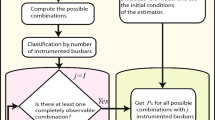Abstract
Different power amplifier (PA) models have their own effects on PA linearization. In this paper, the nonlinear characteristic of the radio frequency power amplifier (RF PA) is simulated based on the two models combining predistortion technology, and the nonlinear effects of the two models are analyzed, respectively. The simulation results show that Power Series model normalized mean square error (NMSE) is −37.8 dB, which is less than Power Series model −30.4 dB before loading predistortion technology. NMSE of the two systems are −23.4 dB and −26.0 dB respectively, while Saleh model compensates better than the Power Series model combing predistortion technology. The error vector magnitude (EVM) of Power Series model is only 6.75%, whereas the Saleh model EVM is 9.99%, indicating that Power Series model can better describe the nonlinear characteristic of PA. It will have a positive effect on improving the power utilization of wireless communication system.
Similar content being viewed by others
References
Jeckeln E G, Ghannouchi F M, Swan M A. A new adaptive predistortion technique using software-defined radio and DSP technologies suitable for base station 3G power amplifiers [J]. IEEE Trans on Microwave Theory and Technique, 2004, 52(9): 2139–2147.
Saberkari A, Ziabakhsh S, Martinez H, et al. Active inductorbased tunable impedance matching network for RF power amplifier application [J]. Integration the Vlsi Journal, 2016, 52(C): 301–308.
Kenington P B. Linearized transmitters: An enabling technology for software defined radio [J]. IEEE Communication Magazine, 2002, 40(2): 156–162.
Grebennikov A. RF and Microwave Power Amplifier Design [M]. Beijing: Publishing House of Electronics Industry, 2006(Ch).
Faulkner M. Amplifier linearization using RF feedback and feed forward techniques [J]. IEEE Trans on Vehicular, 1998, 47(1): 209–215.
Cox D C. Linear amplification with nonlinear components [J]. IEEE Trans on Communications, 1997, 22(12): 1942–1945.
Gergis L F. Performance of MF-MSK system with predistortion schemes [J]. International Journal of Managing Information Technology, 2011, 3(1):58–66.
Belabad A R, Iranpour E, Sharifian S. FPGA implementation of a Hammerstein based digital predistorter for linearizing RF power amplifiers with memory effects [J]. Amirkabir International Journal of Science & Research (Electrical & Electronics Engineering), 2015, 47(2): 9–17.
Belabad A R, Motamedi S A, Sharifian S. An adaptive digital predistortion for compensating nonlinear distortions in RF power amplifier with memory effects [J]. Integration, the VLSI Journal, 2017, 57: 184–191.
Boumaiza S, Ghannouchi F M. Thermal memory effect modeling and compensation in RF power amplifiers and predistortion linearizers [J]. IEEE Trans on Microwave Theory and Techniques, 2003, 51(12): 2427–2433.
Tsou W A, Wuen W S, Yang T Y, et al. Analysis and compensation of the AM-AM and AM-PM distortion for COMS cascode class-E power amplifier [J]. International Journal of Microwave Science and Technology, 2009, 2009: 1–9.
Rahkonen T, Aikio J P. Analyzing distortion contributions in a complex device model [J]. The International Journal for Computation and Mathematics in Electrical and Electronic Engineering, 2014, 33(4): 1264–1271.
Chen H, Lin C, Huang P, et al. Joint polynomial and look-up-table predistortion power amplifier linearization [J]. IEEE Trans on Circuits and Systems, 2006, 53(8): 612–616.
Potter C. Uncertainty and design budgets applied to error vector magnitude (EVM) for digital modulation systems [C] // Arftg Conference Digest, Philadelphia: IEEE Press, 2003: 103–109.
Author information
Authors and Affiliations
Corresponding author
Additional information
Foundation item: Supported by the Research Project of Department of Education Hubei Provincial (B2016206), the Huanggang Normal University Science and Technology Innovation Team Program (201613603)
Rights and permissions
About this article
Cite this article
Xie, Y., Xie, W., Chen, L. et al. Linear power amplifier modeling based on predistortion technology. Wuhan Univ. J. Nat. Sci. 22, 395–401 (2017). https://doi.org/10.1007/s11859-017-1264-z
Received:
Published:
Issue Date:
DOI: https://doi.org/10.1007/s11859-017-1264-z




